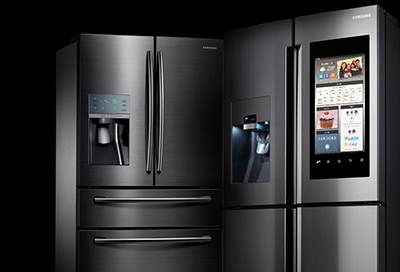
Understand the noises coming from your Samsung refrigerator

A refrigerator is never completely quiet, even when it's new. In fact, new fridges may be louder as they settle into place. Still, noises from your ice maker or compressor should never get so loud that it's interrupting conversation. This guide will review potential noises and advise you of any steps you should take when there is something you can do to prevent the noise.
Snapping, crackling, and popping
The plastic parts of the refrigerator contract and expand as the temperature of the refrigerator rises and falls, causing cracking noises. This usually happens during the defrosting cycle and is much more common in new refrigerators as they acclimate to their new home's humidity and temperature levels. This is a normal sound for all refrigerators to make, and typically fades with time.
The volume of this noise should be comparable to placing ice cubes in a warm drink, or the sound of Rice Krispies. (The refrigerator is much bigger so it will sound a bit louder, but still relatively quiet and dismissable.)
However, if the cracking, popping, or snapping is very loud, visit our Support Center to request service.
Buzzing and humming
If you do not have a water line connected, turn off the ice maker to avoid this noise and damage to your refrigerator.
If you do have a water line connected, you may still hear this noise (at a much quieter volume). This is the sound of water filling the ice maker, which will be louder if water pressure is too high. You can try turning down the water pressure, as long as you can still dispense 3/4 cup in under 10 seconds, which is the minimum pressure required.
These sounds also describe the sound of the compressor. It sounds just like a quiet engine or motor. It will start up, run at low or high speed (and can change speeds), might make some clicking as it operates, and maybe sputters a bit as the fan slows to a stop.
If the buzzing or humming is very loud, visit our Support Center to request service.
Beeping or chiming
If your refrigerator is beeping even when the doors are closed:
- Beeping with a blinking display means the temperature in the refrigerator is too high. This could be normal in some cases, like after a power outage. Correct the cooling issue to resolve the beeping.
- Most Samsung models have a door alarm which will beep if the door is not shut. Open the doors, confirm nothing is in their way, and firmly close them. Some models can toggle this feature with the Alarm setting.
- If the beeping has been happening since the doors were removed and reattached, then the doors were not reattached correctly and service is not required. See your user manual for the proper procedure to connect the wire harness.
- Make sure the beeping is actually coming from your refrigerator and not something else, like a microwave or smoke alarm. One method to check this is to unplug the refrigerator. If the beeping continues, it's absolutely not from your refrigerator.
If the beeping continues, visit our Support Center to request service.
Blowing and whistling
This sound comes from the refrigerator's circulation fans. It's rare, but normal. Slightly repositioning the fridge (moving it an inch or so, while leaving 2 inches of clearance on the top, sides, and back) can sometimes reduce this noise.
If the whistling or blowing is very loud, visit our Support Center to request service.
Hissing, bubbling, or gurgling
Refrigerant moving through the cooling system changes from liquid to gas and back again. This makes a gurgling or bubbling sound.
Water dripping onto the defrost heater makes a hissing or sizzling sound.
If the hissing sound is very loud, visit our Support Center to request service.
Banging
As ice falls from the ice maker into the bucket, it sounds a lot like building blocks tumbling onto a wooden table. A similar noise might happen if something inside the refrigerator was unsteady and fell over.
If a thumping or knocking sound is consistent and very loud (and not the sound of ice falling in the bucket), visit our Support Center to request service.
Grinding
The ice maker can produce a grinding noise when ice is dispensed, especially when crushed ice is selected but even if it's just cubed ice. The sound is often the motor that's pushing the ice forward.
If the noise is very loud, or happens when you're not dispensing ice, visit our Support Center to request service.
Squeaking (from door hinges)
There's a few steps to try if you've got squeaky door hinges. The first three only apply if your refrigerator is new or unused.
- If your doors were removed and then put back on, make sure they were reinstalled properly. Your user manual provides instructions for this.
- If you look under the front of the fridge, the leveling legs should be in full contact with the floor and the wheels shouldn't be touching the floor at all. If that's not what you see, check out our guide for leveling the refrigerator.
- Give it a week of normal use. The harness that runs through the door may not be properly seated in new refrigerators. As the doors are opened and closed on a daily basis, the harness will properly seat itself. If the noise continues after a week, remove the hinge cover and check the wire harness. This is described in your user manual.
- Spray the door hinges with a food grade silicone spray. (Not WD-40, which will remove grease in or around the hinge.)
If the noise continues, visit our Support Center to request service.
Fan hitting ice (and stops when door is opened)
If this noise occurs, visit our Support Center to request service.
The noise is caused by ice buildup around the fan. You can perform a manual defrost to get rid of the ice buildup and get rid of the noise, but only service will correct the original cause. If only a manual defrost is performed, the noise will eventually come back. This is why we recommend service for this issue.
If you perform a manual defrost, DO NOT USE A HAIR DRYER or any other heat source on the refrigerator to speed up defrosting, as this WILL damage the refrigerator.
To perform a manual defrost:
- Remove all perishable items and empty the ice bucket(s).
- Lay down towels underneath the fridge, and keep a good supply of extra towels handy.
- Unplug the fridge and prop the doors open.
- As time passes and the towels get wet, swap them out for dry ones, until the towels stop getting wet or at least 24 hours pass.
- Turn the fridge back on and close the doors. After about 2 hours you can put the food back in.
Rattling
Something behind the fridge might be rattling against it. Move it out an inch to see if that stops the noise.
Rattling can also happen for a couple moments when the compressor turns off, as it putters to a stop. This would be less than 10 seconds at a time and very quiet, though.
If the rattling is very loud, visit our Support Center to request service.
Contact Samsung Support


